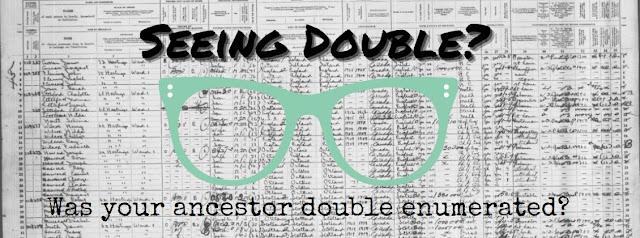Was Your Ancestor Double Enumerated?
- Get link
- X
- Other Apps
Double enumerations are a rare but wonderful things to find when searching for your ancestor in a census. Often times this additional entry can tell us a lot about a person and their life at the time the census was taken. Determining if someone was actually double enumerated can be tricky but is definitely worthwhile.
What is a double enumerations?
A double enumeration is a statistical error of sorts, on the enumerators part, where the same person is recorded two times in the same census. There are a few ways that this can happen, but the most frequent cause is that the person was living in two different places at the time. For example, a child in the household may have been living away at school but also have been recorded as living with the family back home.
How to tell if they are the same person?
The more recent the census, the easier it is to tell if two entries are truly the same person. The reason for this is that more recent census returns offer more information about the individuals living in a household. Although the added detail of newer census returns makes it easier to identify your ancestor, old school census analysis is still one of the best methods. Simply comparing both returns against what you already know about the person is often times the best place to start. Pay close attention to how your ancestor is related to each household - this can be beneficial when applying your FAN club research. Looking at how the people they are living with fit into their FAN can be really helpful because often times those people are already there! Back in the day the family structure was quite different than it is today. People lived together longer and often times took in aged parents and relatives.
Lets look at an example:
When I searched for my great grandfather in the 1921 census, I had two very similar results. I knew the first results was definitely him because the other members in the household matched perfectly with what I already knew his parents and siblings. The first one had the following information:
Edward, age 17, born Nova Scotia, parents both born in Nova Scotia, working as a carpenter
The second entry was only one town over and listed him as a 'nephew' to the head of the household. It contained the following information:
Edward, age 17, born Nova Scotia, both parents born in Nova Scotia, working as a mechanic
Aside from his occupation, the two entries were identical. At first I thought there might be two men with the same name and the same age. I needed to dismiss this theory in order to determine that he had truly been double enumerated. I started by searching the 1911 census to see if there was anybody else with the same name and age - there were none in the area. On its own, that is not enough information. To be sure I would need to investigate his relationship to the head of the household. When I started examining them, one thing caught my eye - the last name. Although the surname was different than my great grandfathers, it was the same as his mother's maiden name. To prove that he was also the nephew in the second entry, I had to prove that Colin (the head of the household) was my great grandfather's uncle (or rather my 2x great grandmother's brother). When I went back in census returns, everything checked out, right down to the other members of the household, thus confirming that my great grandfather was double enumerated in the 1921 census.
Of course this prompted me to ask the question: why was he living with his uncle? and why were two of his cousins also living there?
Lets me start by explaining that although Colin was the head of the household, his sister Sarah (Sadie) was also living there. Both of them never married and consequently never had children of their own. Although the exact reason for them never marrying is not definitive, it is likely the result of them having to raise their niece and nephew after their brother died in a mining accident in 1911. Ten years later, Edward had started living with them. Once again, the reason is not completely known but it is likely that he moved in because of Colin's illness. Colin died of tuberculosis during March 1922, after having battled it for two years. Edward might have went to live with Colin and Sarah to help take care of Colin.
By finding my great grandfather double enumerated in the 1921 census, I was able to better understand his relationship with his mother's side of the family. This is something I would not have known about had he not been double enumerated.
- Get link
- X
- Other Apps




Comments
Post a Comment